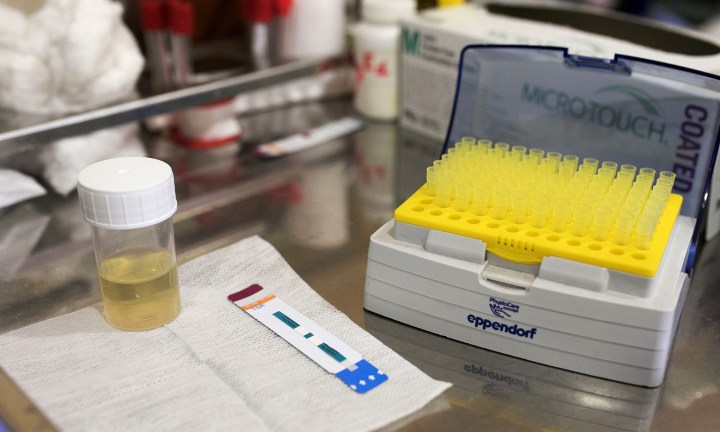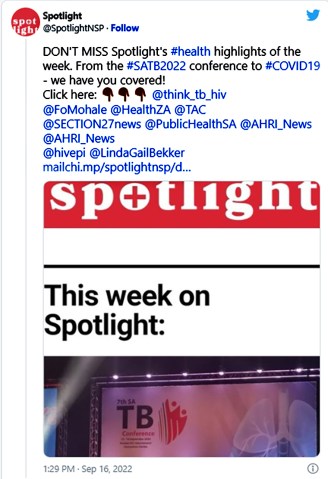SPOTLIGHT IN-DEPTH
After slow start, uptake for urine TB test is picking up

In 2015, the World Health Organization recommended a urine test that helps detect tuberculosis in people living with HIV who are in hospital or who have compromised immune systems. While uptake of this test in South Africa was initially slow, numbers presented at the recent South African TB Conference suggest it is increasing.
While tuberculosis (TB) is the top killer of people living with HIV, TB is also harder to diagnose in people living with HIV than in people who are not. What is more, TB is particularly difficult to diagnose in people living with HIV who have compromised immune systems.
Imagine, for example, someone living with HIV is very sick in hospital. It is not known whether the person has TB. They may not be coughing much and may be unable to cough up the sputum required for the standard molecular TB test, which takes at least a few hours to do.
This is where the urinary LAM (or ULAM) test can make all the difference. Much like a pregnancy test, all that is required is a urine sample and the test kit. It takes 25 minutes to get a result. If a diagnosis is confirmed, the patient can immediately start TB treatment.
Yet, while the case for using ULAM in such circumstances is compelling, the World Health Organization (WHO) first recommended its use in 2015, and uptake of the test in South Africa has been slow. But, based on presentations at the seventh South African TB Conference in Durban recently, use of the test is now increasing. The WHO published an expanded recommendation for ULAM in 2019.
Why ULAM?
LAM stands for lipoarabinomannan, which is a component of the outer cell wall of the TB bacterium. Some LAM that is shed from TB bacteria can be excreted through urine. A ULAM test simply looks for these fragments.
One benefit of ULAM is that urine samples are much easier to obtain than sputum. The current gold-standard molecular TB test used in South Africa, the GeneXpert, requires people to cough up sputum – which many, especially children and people living with HIV who have compromised immune systems, find difficult.

With the ULAM test, it takes 25 minutes to get a result. If a TB diagnosis is confirmed, treatment can start immediately. (Photo: medicinenet.com / myhealth1st.com. / Spotlight)
Professor Keertan Dheda, general physician, pulmonologist and critical care specialist who heads up the Division of Pulmonology at Groote Schuur Hospital and the University of Cape Town, told the conference that the challenge with HIV patients is that they are sputum-scarce and struggle to cough. “You can’t really get a proper sputum (sample) because most of them are not able to cough it up. That is why we need a test that works well for these patients,” he said.
Faster turnaround
Another benefit of ULAM is that it produces results in 25 minutes and the test can be done at the point of carem, whether in a clinic or at a patient’s bedside. Most of the molecular TB tests available in South Africa require samples to be taken to a lab and results are available in a few hours at best.
Diagnosing TB quickly really matters when someone is sick enough to be in hospital. “About 50% of TB deaths in the hospitals are undiagnosed, hence a rapid diagnosis is needed,” said Dheda.
“ULAM is indicated for people living with HIV with advanced disease, which means they are already very sick,” said Neeltjie le Roux, quality improvement adviser at the Aurum Institute, an NGO. “As healthcare workers, we do not want to miss TB in people living with HIV, as we don’t want patients to die from a disease we can cure. Thus, starting with TB treatment promptly is vital and this test helps us to do that.”
The quicker turnaround time also has benefits for clinic patients with compromised immune systems who haven’t been admitted to hospital.
Read more in Daily Maverick: “Is the future of South Africa’s TB plans locked up in the mysterious minds of teens?”
“In terms of time, with ULAM the test result is within 25 minutes, while the patient is still present, whereas with GeneXpert the results take at least six hours (and this is after it has been received and processed at the lab), thus patients have to wait at least a day or two for diagnosis, and have to return to the facility for their result and treatment initiation – causing a delay in starting treatment and at a higher cost for patients to return because they will need transport or a day out from work, among other things,” said Le Roux.

From January to July 2022, Think TB did 1,696 ULAM tests in KwaZulu-Natal. (Photo: Spotlight)
“It is still important to follow up with sputum tests when the patient can produce sputum/phlegm, as ULAM can tell us if the patient has TB, but it does not distinguish between drug-sensitive TB or drug-resistant TB,” said Le Roux. “Research found it (ULAM) results in quicker TB diagnosis, reduces mortality (by having a quicker diagnosis and being able to start treatment earlier), and it greatly improves diagnostic yield when used with other tests.”
At just under R70 for a box of 25 test strips, the ULAM test is also cheap.
Low sensitivity
Dheda told the conference that the ULAM tests have 25% sensitivity, but stressed that the sensitivity changes depending on how sick someone is. “It is only effective in patients who are HIV positive because people who are very sick excrete a high amount of bacteria in their urine – enough for the test to detect,” he said. “Sensitivity gets stronger as the CD4 count decreases. This is a test to use for HIV patients, it saves lives.” (A low CD4 count indicates that the immune system is compromised.)
Visit Daily Maverick’s home page for more news, analysis and investigations
Another strength of ULAM is that it can help detect TB in parts of the body other than the lungs. Since sputum has limited value in diagnosing such extrapulmonary TB, more invasive tests are often required. ULAM has potential as a replacement or adjunct to some of those tests.
There is evidence that a newer ULAM test made by Fujifilm is more sensitive than the test made by Abbott, which is currently being used in South Africa. What implications the increased sensitivity might have for how the test is best used is not yet clear. Spotlight understands that the use of the Fujifilm product is to be piloted in South Africa.
Since the currently available ULAM tests have very low sensitivity in people with higher CD4 counts, it is not useful for TB testing more generally. This nuance may be one factor contributing to the limited uptake of this test in South Africa – others appear to be a lack of awareness and in some cases insufficient supplies of test kits.
But following new national guidelines on ULAM released in 2021, steps are being taken to increase awareness and use of ULAM in several provinces, including KwaZulu-Natal, the Eastern Cape and the Western Cape.
Uptake in provinces
Dr Lynette Duckworth, technical TB lead for Think TB, an NGO that works with the government, said from January to July 2022 they did 1,696 ULAM tests in KwaZulu-Natal. “Of those that we tested, 347 tested positive, giving us a yield of 20%. We then started 344 on TB treatment. This is 344 people, who would potentially have been otherwise missed, who were started immediately on treatment between January and July.
“A total of 764 healthcare workers and 170 intern doctors and doctors have been trained through all the four supported districts (uMgungundlovu, uThukela, Amajuba, and uMkhanyakude),” said Duckworth. “We had to provide formal training to all facilities in our supported districts.”
According to Simphiwe Mayaphi, district programme manager for the Maternal, Adolescent and Child Health Institute (MatCH, an NGO), ULAM use has dramatically increased at the six hospitals where they work in the Eastern Cape.
“We have improved ULAM testing by 700%, comparing the baseline of April 2021 to September 2021 to the last six months of October 2021 to March 2022,” he told the conference. “There has been a yield of 48%.”
Despite the progress, a lot remained to be done in the province. “There is still low uptake at some facilities. There are gaps in recording and reporting. There is still a huge need for information sharing through training to capacitate clinicians. We must also ensure guidelines are available for reference purposes,” said Mayaphi.
Read more in Daily Maverick: “Government outlines nation’s TB recovery plan as testing volumes show improvement”
Le Roux told Spotlight that in the West Coast district of the Western Cape only two hospitals used ULAM tests in June 2021. Today, she said, all seven of the district’s hospitals are using it. The next step is making the test available to primary healthcare facilities (clinics and day hospitals).
Between October 2021 and July 2022, she said a total of 220 people living with HIV received a ULAM test at the seven hospitals. Of these – 67 (30%) tested positive for TB. Of the 67 who tested positive, 62 (93%) were initiated on TB treatment, while three (4%) not initiated on treatment died before treatment began.
Byron la Hoe, Western Cape health department spokesperson, said ULAM tests were issued to 133 facilities in the province between August 2021 and September 2022. These included several City of Cape Town clinics as the use of the test is determined by client profile.

“Because it was a new test, training had to be scaled up to include all healthcare workers in the province. The training has practical and theoretical aspects and therefore has taken some time to cascade to all facilities. Healthcare workers lacked confidence to use the test initially, but uptake has been increasing as they become familiar with it,” La Hoe said.
Getting nurses on board
Duckworth said use of the test has always been doctor-driven.
“Traditionally urine LAM has been requested and performed by doctors. Because it is doctor-driven, intern doctors sometimes are way too busy to do the test and do other things, [and] come back to check the test later which will not give accurate results. We need to be empowering nurses in hospitals to do the test to increase nurse-led testing. It can be done in the wards and not be limited to doctors,” she said.
She said the other challenge they encountered in their implementation was stockouts, although that had eventually been resolved. “ULAM is ordered through the pharmacy, and it is put in one central place in the hospital which limits its usage. There is a need to support it with decentralisation to wards and outpatients to improve accessibility.” DM/MC
This article was published by Spotlight – health journalism in the public interest.



















 Become an Insider
Become an Insider
Comments - Please login in order to comment.